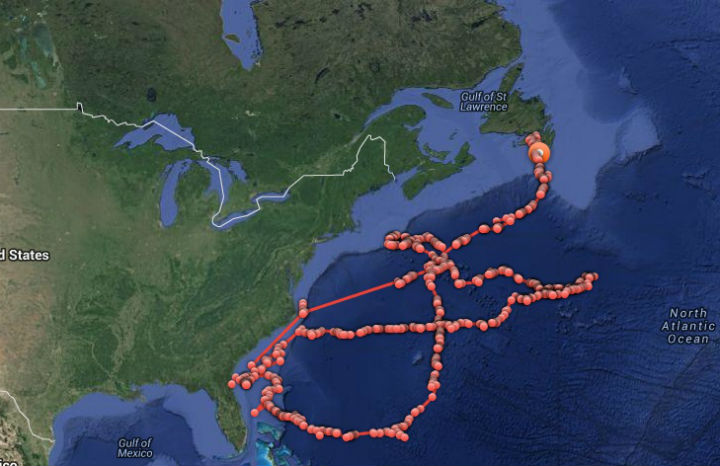ABOVE: A great white shark tagged near Florida has been tracked off the coast of Newfoundland. Ross Lord reports on how the tagging is helping researchers understand the sharks’ habits.

HALIFAX – When you think of the waters off the coast of Newfoundland you’re more apt to think about great icebergs rather than great white sharks.
But a 4.4-metre shark named Lydia is the talk of the Rock this week, after swimming her way up the Atlantic from Florida to Placentia Bay.
Lydia, named by the researchers who tagged her off the coast of Jacksonville on March 3, travelled about 17,000 kilometres on her journey north — clearly not taking the most direct route.
Non-profit organization Ocearch has tracked 46 great whites off the coast of North America and South Africa, in hopes of better understanding the beasts’ movements.
Most of the sharks are where Ocearch expects them to be, but not Lydia.

Get breaking National news
“I think all of us are surprised we find Lydia in Newfoundland this time of year,” Ocearch expedition leader Chris Fischer said in a Skype interview with Global News on Tuesday. “It would have been less surprising if it would have been August or something like that, more late summer.”
The Ocearch team began tracking Lydia’s movements into Canadian waters around Oct. 17, wondering if she might be heading to the seal-populated Sable Island — a buffet for a great white, really.
But then she kept going further north, towards Newfoundland.
Ocearch alerted Newfoundlanders about their razor-toothed tourist in a Facebook post on Sunday.
“Lydia is definitely chilling out off the coast of Newfoundland – a realtime weather buoy is reporting sea surface temperatures of 49F(9C) in the vicinity of her latest position. But what is she doing so far north, so late into the fall? Lydia seems to enjoy dispelling every generalization that we come up with in terms of white shark migration in the north Atlantic,” the posting read.
As of Monday morning, she was off the coast of Marystown.
Fischer said the team has been waiting for a shark to head north. Lydia was that “miracle,” he said.
“We don’t understand the full migratory range of the males or the females and until we solve that puzzle, we can’t effectively manage their future,” he explained. “Sharks like white sharks are the lion of the ocean. They are the balance-keepers. If we lose them, we will lose the oceans.”
For Dr. Steve Campana, head of the Canadian Shark Research Laboratory in Halifax, said Lydia is certainly the first great white to swim up to Newfoundland. But, like Fischer, he said it’s “extremely rare” to confirm one’s presence this far North at this time of year.
‘We don’t quite know what she’s doing there, but probably having a little bit of a feed,” he said.
But more importantly, any information that can be gathered about where great whites are at different times of the year could be invaluable in efforts to conserve their numbers.
“We’re very concerned about the continu(al) survival of great white sharks,” he said. “If we don’t know where they are, we can’t protect them.”
He added some estimates suggest the number of great whites in the Atlantic Ocean is down 90 per cent from 30 or 40 years ago.









Comments